Soft Sediment Deformation
Soft sediment deformation (SSD) is widespread in many sedimentary successions. Here some good examples of the main types of sediment deformation as discussed in Ortner (2007). The structures are ordered tentatively from early to late in relation to lithification of sediments.

Subsurface fluidization - primary sedimentary structures destroyed
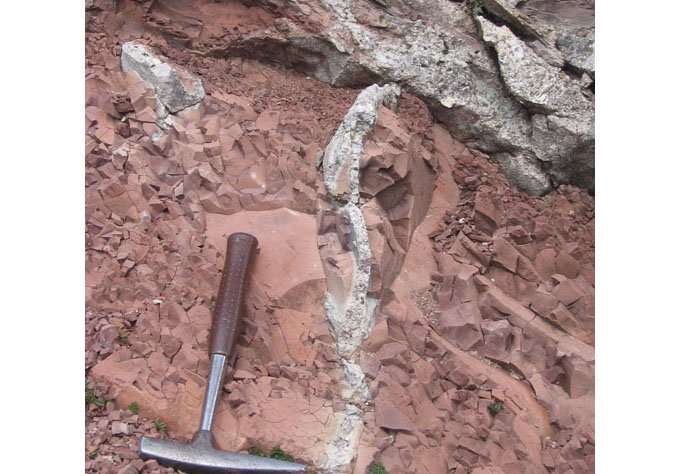
Sedimentary dyke in a fluidized zone below Rotkopf (Gosau Group of Muttekopf).
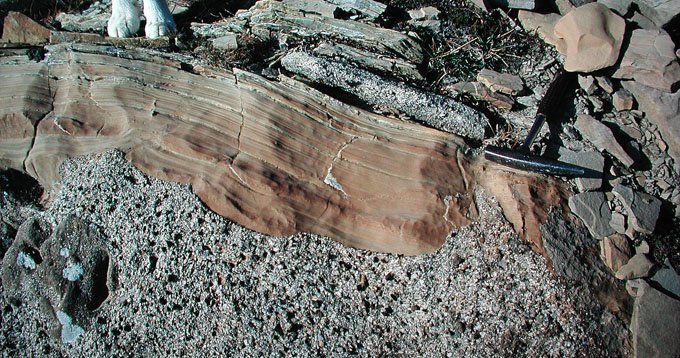
Fluid overpressure in coarse-grained sediments causes formation of flame structures into finer-grained sediment, that deforms hydroplastically. After expulsion through the relatively strong sandstone, the conglomerate forms a sill in softer marls (Gosau Group, Muttekopf).

Coarse grained sedimentary sill in fine-grained sediments. Intrusion of sill caused local contortion of fine-grained material (arrows) (Gosau Group. Muttekopf).
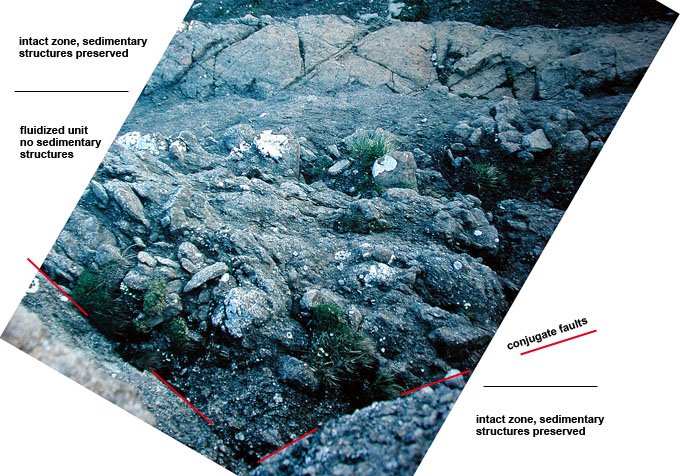
Fluidization in a thick conglomerate to sandstone graded bed (Gosau Group of Muttekopf). In the inner fluidized unit silt- and sandstone clasts float in a conglomerate matrix, pointing to inhomogeneous lithification prior to fluidization. The undisturbed parts of the beds at bottom and top show conjugate joints symmetric to bedding. Joint surfaces delimit the fluidized unit against the siltstone and must therefore predate fluidization. Probably bedding-parallel shortening caused rise of fluid pressures and hence fluidization.

Fluidization in a conglomerate sandstone multilayer unit (Gosau Group of Muttekopf). Fluidized layer 1 formed at the tip of a minor thrust cutting upsection from right to left. Sandstones within are isoclinally folded (inset upper left), while grading and lamination is well preserved. Interstitila space between folded sandstone beds is injected by conglomerate matrix. In fluidized layer 2, heterolithics are folded and injected by a sandstone matrix.
Hydroplastic deformation - primary sedimentary structures preserved and deformed
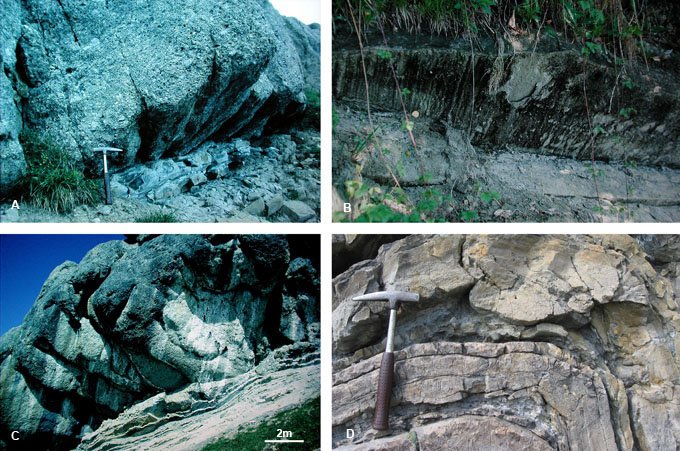
Soft-sediment mullions. A Symmetric mullions at the base of conglomerate in contact with marl (Gosau Group, Muttekopf). B Symmetric mullions at the base of a sandstone bed (Unterangerberg Fm., Intra-Alpine Molasse). C Asymmetric mullions at the base of conglomerate in contact with marl (Gosau Group, Muttekopf). D Mullions in the inner arc of coarse-grained beds in fold hinges (Gosau Group, Muttekopf).
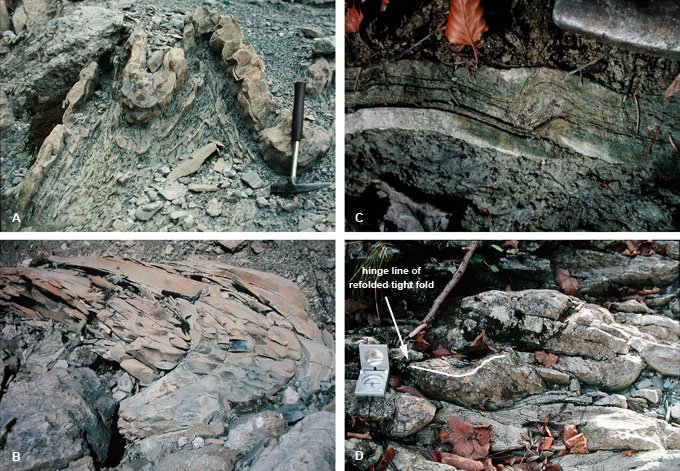
Soft-sediment folds. A Folded heterolithics, cuspate-lobate folds in sandstone, thickened fold hinge, stretched fold limbs, axial-plane cleavage in marls (Gosau Group, Muttekopf). B Similar fold in marks (Gosau Group, Muttekopf). C fault-propagation fold in sandstone, thickened fold hinge (Unterangerberg Fm., Intra-Alpine Molasse). D Tight similar fold refolded by isoclinal parallel folds (pelagic limestones, Ammergau Fm., Ampelsbach).
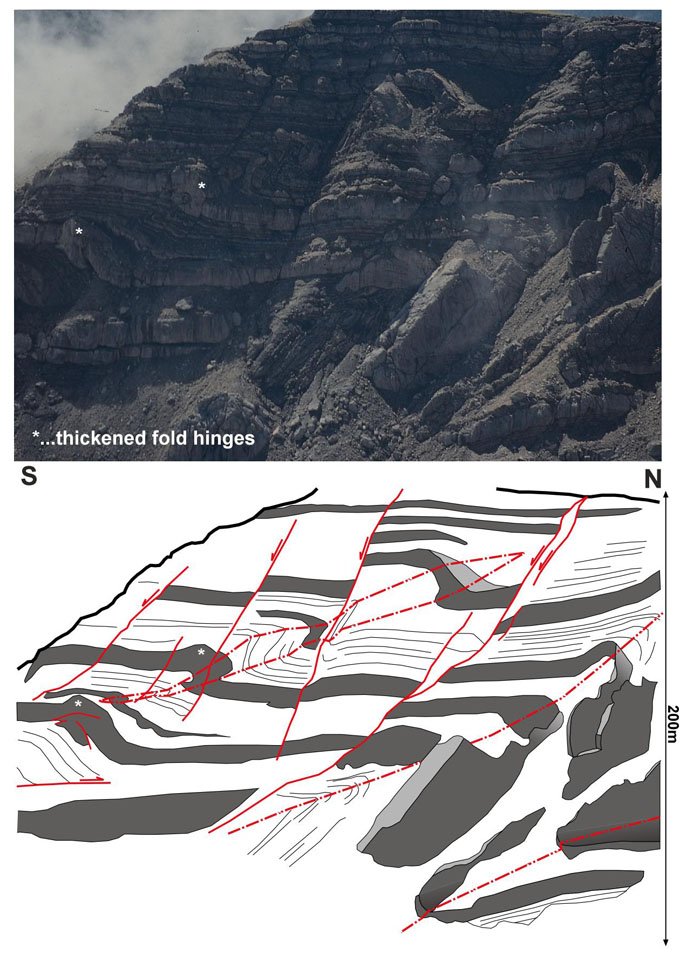
Several fault-related folds crop out in the north face of Pleiskopf. The coarse-grained beds were not fully lithified during deformation, and flow of material toward the fold hinges caused thickening of fold hinges.
Semi-brittle deformation

Semi-brittle fold, refolding a fluidized unit. Multiple stacking in the sandstone bed probably due to reduced shear strength during ongoing lithification. Note plastic deformation (p. d.) in lower sandstone bed and near the core of the upper fold. (Gosau Group, Muttekopf).
